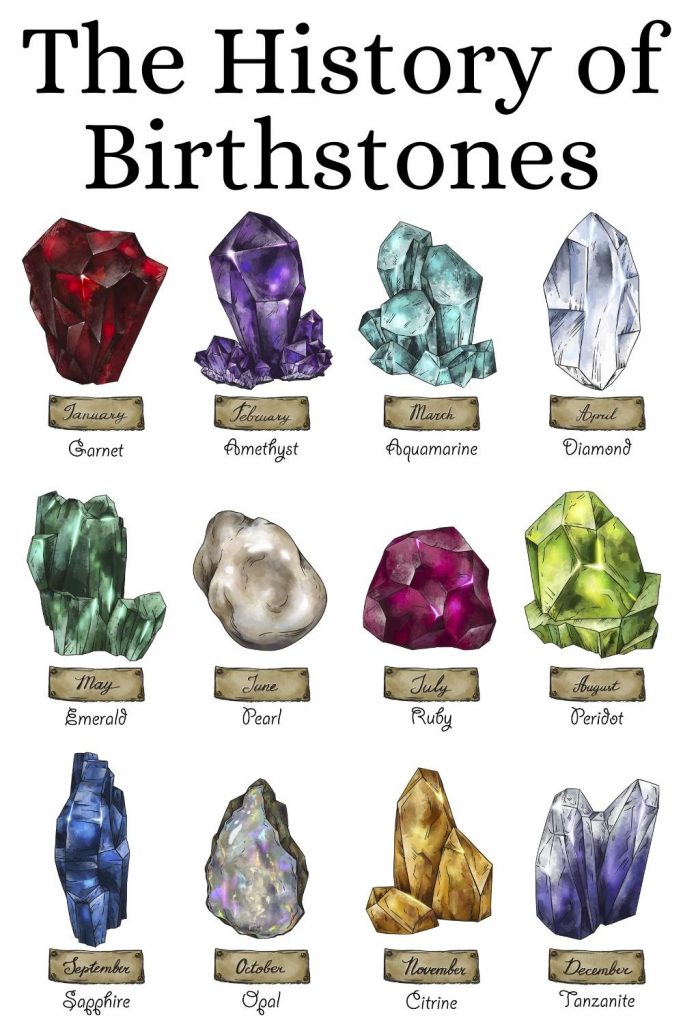Estimated reading time: 4 minutes
Birthstones have fascinated people for centuries, blending ancient traditions, mystical beliefs, and personal meanings. From their biblical beginnings to the polished lists you’ll find in modern jewellery shops, these gems are more than just pretty stones, they’re tiny, tangible pieces of history. Whether worn on a ring or tucked into a necklace, each one tells a story.
Jump to:
Origins in Antiquity
The journey of birthstones starts thousands of years ago, rooted in biblical history and the legendary Breastplate of Aaron. This ceremonial garment, described in the Book of Exodus around the 5th or 6th century BCE, was worn by the high priest of ancient Israel. It featured twelve distinct gemstones, each representing one of the twelve tribes.
These stones weren’t just ornamental. They were believed to hold divine power, offering protection, guidance, and a spiritual link between the wearer and the heavens.
As time went on, the Greco-Roman world picked up where the Hebrews left off. Philosophers and astrologers began linking the twelve stones not just with the tribes of Israel, but with the twelve signs of the zodiac, believing that wearing the right gem at the right time could enhance both spiritual and physical well-being.
Interestingly, it was more common at this time to wear all twelve stones at once. Why? It was thought a full set would keep you protected throughout the entire year, no matter what the stars had in store.
The Shift to Monthly Birthstones
Over time, the practice of wearing all twelve stones evolved. By the 8th or 9th century, the tradition had shifted toward something simpler: one gemstone assigned to each month of the year.
Why the change? Some suggest religious leaders may have promoted a more personalised approach to help individuals connect with a single stone that reflected their birth and identity. Of course, practicality likely played a part too, most people couldn’t afford jewellery featuring twelve different gems!
By the Middle Ages, this idea of a monthly birthstone had spread widely across Europe, particularly in Poland. Ancient symbolism met growing personal sentiment, and the birthstone became a cherished keepsake rather than just a protective object.
How were the modern birthstones chosen?
By the early 20th century, there was still plenty of debate about which stone should represent which month. So in 1912, the American National Retail Jewelers Association (now Jewelers of America) stepped in to standardise the list.
Their goal? To make jewellery shopping easier, and more specifically, to make birthstone jewellery more marketable as meaningful gifts.
Since then, the list has been updated a few times to reflect newly discovered gemstones, availability, and shifting trends. Tanzanite was added to December’s list in 2002, and in 2016, spinel became an alternative August birthstone, bringing a modern twist to an ancient tradition.
Today’s Birthstone List
Here’s the current line-up of birthstones by month:
January: Garnet
February: Amethyst
March: Aquamarine
April: Diamond
May: Emerald
June: Pearl, Alexandrite, or Moonstone
July: Ruby
August: Peridot or Spinel
September: Sapphire
October: Opal or Tourmaline
November: Citrine or Yellow Topaz
December: Turquoise, Zircon, or Tanzanite
A Tradition Worth Celebrating
From ancient breastplates via zodiac talismans to modern gift-giving, birthstones have come a long way, but they’ve never lost their charm. Today, they’re personal, symbolic, and as captivating as ever.
Whether you’re drawn to a birthstone for its colour, meaning, or cosmic connection, wearing yours is more than just a style choice. it’s a personal celebration of who you are.
📌 Pin this guide to birthstone history so you’ll always have the full list, and the stories behind it, at your fingertips!



